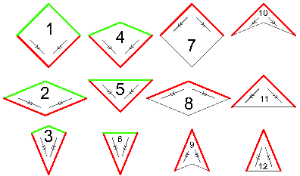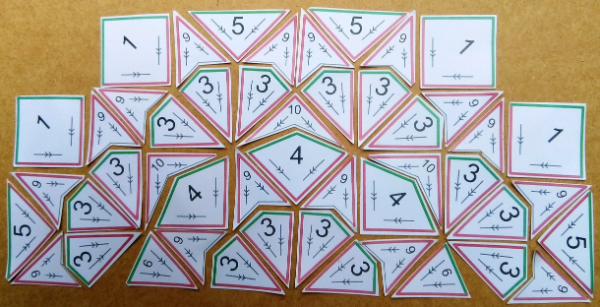Paper Tiles
Paper tiles are a tool to find out the way a muqarnas is organised, especially to recognize the different layers. One of the muqarnas systems, mainly found in Turkey, consists of fourteen different elements. Seven of them have walls and a roof. We call them full units. Seven of them do not have walls. They fit within the roofing of a layer. We call them intermediate layers.
The Iranian system consists of less elements and do not distinguish between full or intermediate.
But there is also a 30° system and the Western Islamic system has different elements too.
We started with the Turkish 45° system.
![[size=100]Participants made an attempt to reconstruct the muqarnas design by placing the paper tiles in the right possition.
The muqarnas design (in green) shows the boundaries of each element but does not show the boundaries of the layers.[/size]](https://beta.geogebra.org/resource/c7ssa5dq/WNkC36nI2b8JIxOt/material-c7ssa5dq.png)
Set of tiles

Rules
According to the set of rules of back on front
- a wall of a full element should be stacked on the end of an intermediate elements (green to black)
- adjoining roofs have the same orientation (red to red, arrows pointing to same direction)
- a wall of a full element can be stacked on the end of an intermediate element (green to black)
- a wall of a full elements can be stacked on the roof of a full or an intermediate element (green to red)
- adjoining roofs have the same orientation (red to red, arrows pointing to same direction)
Student exercises

Advanced examples

![[size=100]This one is made for a muqarnas in Natanz.
See my website [url=http://www.fransvanschooten.nl/fvs_muqarnas_uk.htm#Natanz]muqarnas in a niche of the the Ilkhanid Shrine complex at Natanz
[/url]This design follows the set of rules back on curve.[/size]](https://beta.geogebra.org/resource/zfc2rx85/FYIuserTo7bnsGql/material-zfc2rx85.png)
![[size=100]This very large one is an attempt to understand the muqarnas of Takht-i-Sulayman, as described by Yaghan and Harmsen.[/size]](https://beta.geogebra.org/resource/kdg4b4dv/CZsLwrtllV12ERIH/material-kdg4b4dv.png)